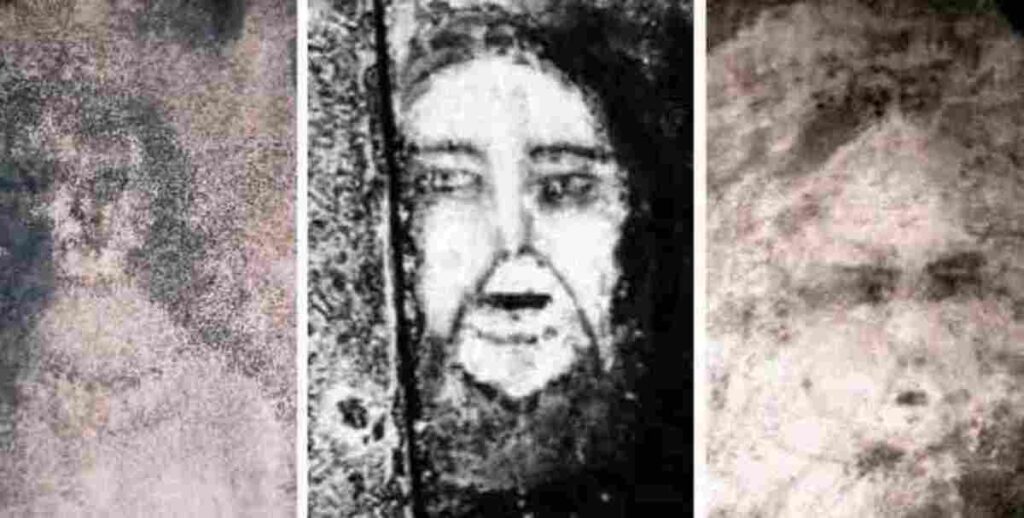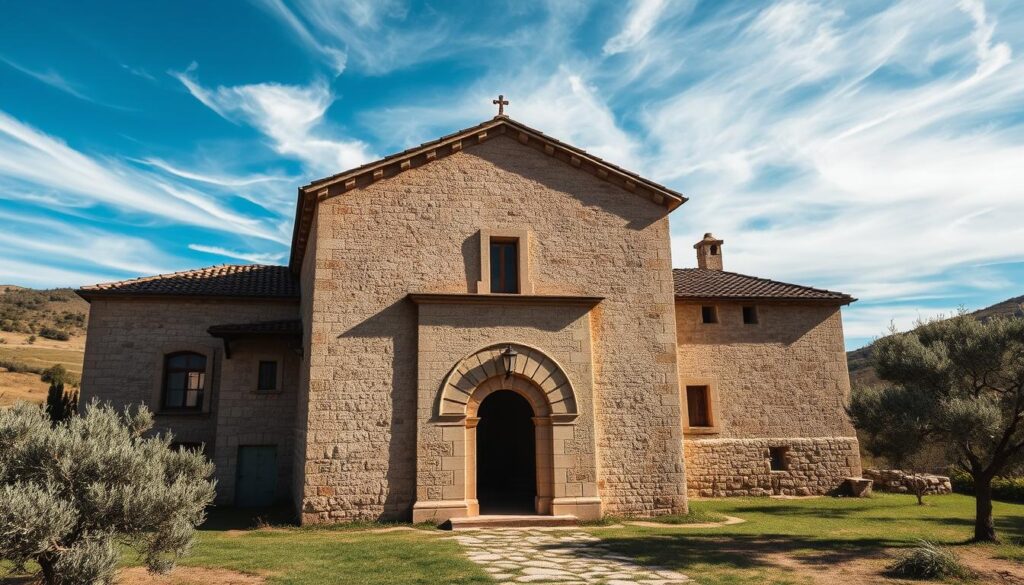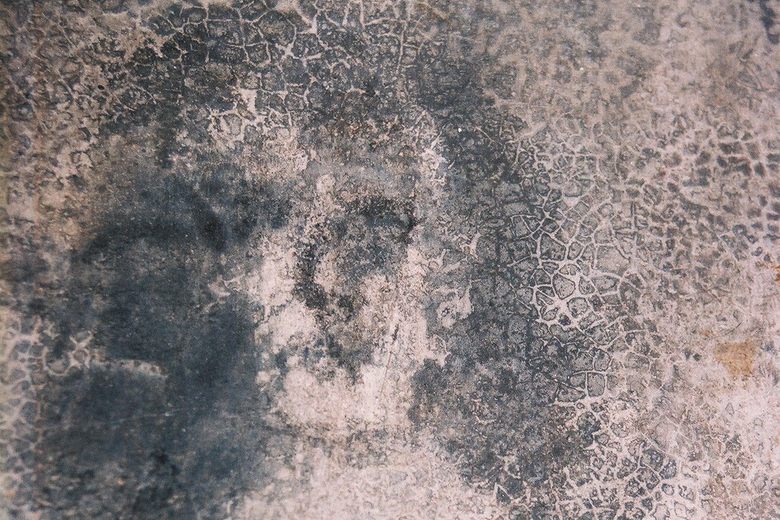I first heard this story in a travel column, but the account followed me as I studied its odd details. In 1971 a humble concrete floor in a small Andalusian house at Calle Real 5 developed stains that looked like human faces.
The homeowners scrubbed, broke up the slab, and re‑cemented the floor, yet the images returned and spread to other rooms and walls. Excavations later revealed medieval skeletal remains under the kitchen, but new images still formed after reburial and fresh concrete.
Parapsychologists and scientists examined the place. Skeptics pointed to chemical agents, and some tests suggested silver nitrate and chloride. Still, no explanation has satisfied both sides, so the mystery keeps drawing visitors from around the world.
I will trace the first sightings, the family’s response, excavations, scientific tests, hoax claims, and how the site functions today as a visited place in a small town near Jaén.
Key Takeaways
- I introduce the 1971 origin: humanlike stains appeared on a kitchen floor in a Spanish home.
- Attempts to remove the images failed; they reappeared and spread through the house.
- Excavations found medieval remains, but new images still formed after reburial.
- Researchers and skeptics clashed: no single explanation resolved the case.
- The site remains a famous, visitable place that blends history and controversy.
How it began in Bélmez de la Moraleda: the 1971 kitchen-floor faces
What began as a faint mark on the concrete kitchen floor at Calle Real 5 soon hardened into a startling, face‑like image. In August 1971, maría gómez noticed a stain that would not wash away.
She scrubbed the spot until the area shone, but the stain deepened and, to her surprise, took on human contours. Her husband and son returned with a pickaxe and broke out the patch. They re-cemented the kitchen floor, hoping the problem was solved.
About a week later the same image reappeared in the new surface. Other stains formed nearby and some seemed to shift position. The household—sometimes reported under the pereira family name in later accounts—felt besieged by a recurring mark that acted more like a living presence than a simple blemish.

The news traveled fast through the town. Inhabitants came to see the kitchen, and visitors arrived from farther afield. That private problem at the house bélmez on Calle Real 5 turned into a public curiosity almost overnight.
- First sighting: a stubborn stain on the concrete kitchen floor.
- Family reaction: scrubbing failed; husband used a pickaxe.
- Return: the image came back after re‑cementing, then more faces appeared.
Unearthed beneath the house: skeletons, a buried past, and the village story
When workers dug under the kitchen, earth gave up skeletal remains that villagers linked to an old cemetery.
Excavation beneath the kitchen: remains tied to a 13th‑century cemetery
I walked the excavation decision with locals and investigators. They found skeletons and dated the find near the 13th‑century cemetery line. The remains were later reburied in the local cemetery.
New floors, new faces: why the images kept returning across rooms and years
The team poured fresh concrete on the floor, yet within weeks new faces appeared. Over the years the stains moved beyond one room and showed up on walls. That cycle—dig, reburial, re‑cement, reappearance—made the cause hard to pin down.
Local legends and reported psychophonies: what people say they heard and saw
Parapsychologists claimed to record psychophonies. Villagers described strange noises and rare apparitions that fed local stories. Each new photograph and retelling tightened the place into village lore and kept interest alive.
- Skeletons under the kitchen tied to a 13th‑century burial.
- Reburial did not stop fresh faces from forming on the new floor.
- Over the years the bélmez faces story grew through photos and eyewitness accounts.

Ghost of Belmez under the microscope: researchers, scientists, and skeptics
Experts came with cameras and probes, determined to map each stain and test its material makeup. The arrival of foreign and local researchers framed the event as a studyable phenomenon that drew attention from around the world.
Parapsychology arrives in Andalusia
Parapsychologists tried to classify what they observed. Some recorded alleged psychophonies and filed reports that placed the site in catalogs of hauntings and psychic events.
Laboratory looks
Chemical and microscopic work followed. Teams of scientists analyzed concrete and pigments but could not fix a single cause. Lab results narrowed options yet left the core question open.
Hoax hypotheses and reported history
The newspaper El Ideal reported tests hinting at silver nitrate and chloride. That method has a 1940s history and fueled a prominent hoax theory.
After 2004: blurred features
When maría gómez cámara died in 2004, some faces blurred and lost detail. Others saw this as proof of fading trickery; some experts read it as a shift in the phenomenon.
- Parapsychologists classified and recorded psychophonies.
- Laboratories ran chemical and microscopic analyses without a final verdict.
- El Ideal raised a silver nitrate/chloride hoax claim linked to historic techniques.
| Investigators | Method | Findings |
|---|---|---|
| Parapsychologists | Field recordings, psychophony | Classified phenomenon; audio claims |
| Laboratory scientists | Chemical & microscopic tests | No definitive cause determined |
| Press & skeptics | Historical research, chemical tests | Hoax hypothesis: silver nitrate/chloride |
Debate endures: skeptics challenge authenticity while believers hold to the phenomenon. The story remains unsettled, and the faces keep drawing scrutiny.
The place today: visiting the Bélmez Faces in Jaén, Spain
To reach bélmez moraleda I drove from Jaén on the state road N‑323a, then took the A‑324 east toward Cambil and Huelma until the town signs appeared. The route is simple and places you near the center quickly.

At Calle Real 5 the house bélmez stands as a small public attraction. I looked for the photo‑documented spots: the original kitchen floor, adjacent rooms, and marked wall areas where people reported faces.
As a tourist, I kept expectations modest: many features are subtle and some images blurred after 2004. I focused on photos, displays, and local accounts rather than hunting for a single clear face.
Respect matters. This home sits inside a village where people live with the story. I asked about visiting hours, followed local guidance, and treated the house and its residents with care.
- How I got there: N‑323a, then A‑324 east to bélmez moraleda (town access).
- What to look for: kitchen floor patches, walls, and documented areas in the house bélmez.
- Why stay curious: on‑site notes discuss both paranormal claims and scientific attempts to explain the cause.
Pair this stop with other places in Jaén province to make the visit part of a wider route and to learn the local context fully.
Conclusion
Decades after the first marks appeared, the little house on Calle Real 5 keeps prompting questions rather than neat answers.
I found that a single kitchen stain on a concrete floor became many faces, and it reshaped how a family and the town’s inhabitants saw their home. Excavations revealed skeletons tied to a 13th‑century burial, yet new images returned after fresh concrete.
Experts, researchers, and scientists studied the site and debated: tests never produced a single cause, and hoax theories remain in play alongside believer accounts.
I note the role of maría gómez and her husband in the early response, and the later change reported after maría gómez cámara died, when some images blurred. Whether you read the bélmez faces as paranormal or a crafted trick, the house bélmez moraleda stands as a living mystery.
If you visit, treat the place with respect. The story continues to evolve as others return, record new observations, and add to the world’s long list of uncanny stories.


Lascia un commento